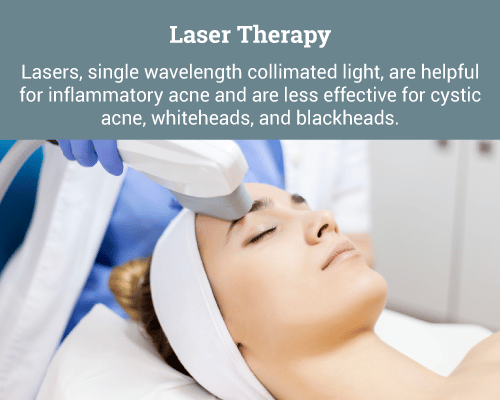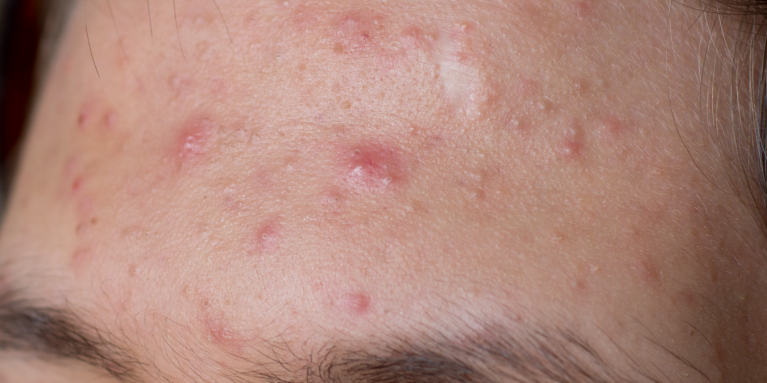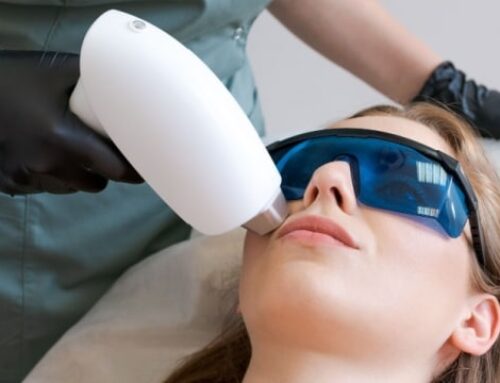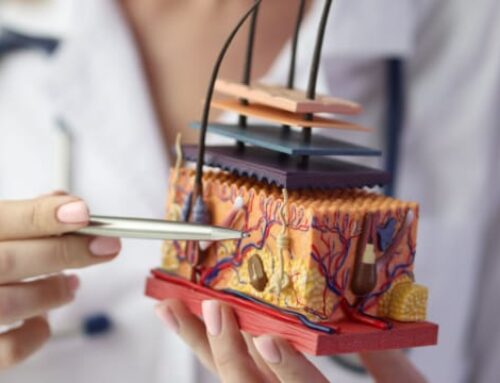Acne can be more difficult to treat than expected, and an effective overall treatment plan often combines two or more types of medication. When more traditional methods aren’t doing the whole trick, light or laser therapy may help to alleviate some of your issues and boost your improvement speed.
Light Therapy
Light therapy uses multiple wavelengths of non-collimated light (beams not lined up) in a limited spectrum to treat acne over a series of exposures. The first FDA-approved light treatment for acne was blue (visible) light, which studies have shown to be more effective at killing acne bacteria than other wavelengths. Blue wavelengths work best for mild-to-moderate inflammatory acne, rather than whiteheads (closed comedones), blackheads (open comedones), and cysts. The light works by activating molecules known as porphyrins in the skin, which accumulate in acne, leading them to destroy the acne from within.
Another type of light source available to treat acne is IPL (Intense Pulsed Light) therapy, which uses a broader spectrum of wavelengths (light colors) to focus on certain pigments to reduce redness, destroy bacteria, and fight inflammation by shrinking sebaceous glands to slow oil production. IPL therapy is most effective for those with light to moderate acne. Photopneumatic therapy combines IPL treatment with a gentle vacuum to remove excess oil and dead skin from clogged pores. It’s suitable for whiteheads and blackheads, but not cystic acne. Photodynamic therapy (PDT), a treatment approved to fight precancerous lesions, is used as an off-label treatment for acne. PDT works by using the same light sources, but activating the involved sebaceous glands and/or acne bacteria by first applying aminolevulinic acid (ALA). This chemical is applied to the skin prior to treatment to achieve extra sensitization for more bacterial killing and sebaceous gland destruction. The challenge with this lies in the possibility of nerve cells absorbing the ALA (rather than cells responsible for oil production), which will cause pain to the patient. Research on photodynamic therapy and acne is limited, so be sure to visit only a board-certified dermatologist for this procedure.

Laser Therapy
Lasers, single wavelength collimated light, are helpful for inflammatory acne (think red papules and pustules) and are less effective for cystic acne, whiteheads, and blackheads. Lasers of the appropriate wavelength work to excite porphyrins inside of acne bacteria, which in turns damages the bacterium’s cell wall enough to kill it. This works by the same principle as PDT. As with other types of light treatment, ALA can be used prior to treatment because it helps activate even more porphyrins, which are responsible for killing the acne bacteria. Unfortunately, this can exacerbate some discomfort caused by the lasers and might darken skin or create folliculitis, which is inflammation of hair follicles. Regardless of which energy source it is used with, ALA sensitizes your skin so much that patients must completely avoid sunlight for up to 30 hours to minimize any side effects.
Laser treatments usually cost between $200 to $500 per treatment with patients generally requiring about three treatments overall to initiate improvement, with maintenance treatments dependent upon the given situation. Clear + Brilliant is an excellent option for those looking for a gentle solution to minor skin blemishes.















Leave A Comment